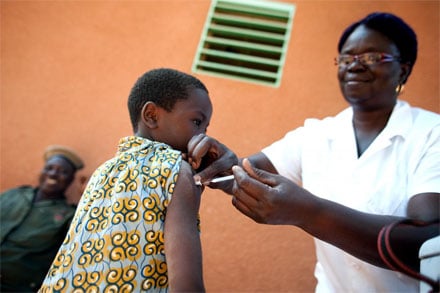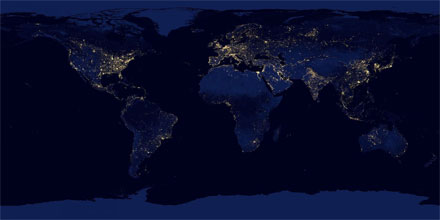Satellite images that capture short-term changes in population size in communities in developing countries could help vaccination campaigns achieve more complete coverage and aid in preventing disease outbreaks.
Vaccination campaigns supplement routine immunization but often fail to achieve coverage goals due to uncertainty about target population size and distribution. Short-term fluctuations in population can significantly impact population size and susceptibility.

Population estimates based on satellite images can help vaccination campaigns achieve more complete coverage. Courtesy of Gabe Bienczycki, USAID.
Researchers at Penn State University used satellite imagery of nighttime
lights in Niamey, Niger, to quantify population fluctuations, and the
coverage achieved by a vaccination campaign conducted in response to a
measles outbreak. They found that vaccine coverage was overestimated
because the campaign underestimated resident numbers, and seasonal
migration further increased the target population.
The researchers combined satellite-derived measurements of fluctuations in population distribution with high-resolution measles case reports to develop a dynamic model that illustrated the potential improvement in vaccination campaign coverage if planners were to account for predictable population fluctuations.
The team's retrospective estimates closely matched actual measurements of the campaign coverage that were made following the outbreak, demonstrating that satellite imagery can improve retrospective estimates of vaccination campaign impact and aid in synchronizing future interventions with predictable population fluxes.
The researchers also showed that estimates of population fluctuations based on satellite images of nighttime lights in two other cities in Niger, Maradi and Zinder, could be used to coordinate vaccination campaigns and other public health interventions even when detailed vaccination records or disease case studies were not available.


Composite image of the Earth at night assembled from data acquired by the Suomi National Polar-orbiting Partnership (Suomi NPP) satellite over nine days in April 2012 and 13 days in October 2012. Population estimates based on similar satellite data can help improve vaccination campaigns. Courtesy of NASA Earth Observatory/NOAA NGDC.
With the satellite data, the effectiveness of vaccination campaigns can
be maximized by coordinating the campaign with predictable seasonal
peaks in population size in the cities, expanding the reach of the
campaign to many people who might otherwise have been missed.
"There's a lot of discussion about the difficulty of reaching the 'last mile,' those people who are well beyond the reach of the conventional health system," said professor Matthew Ferrari. "But if we recognize that the 'last mile' is a moving target because populations are constantly in flux, then we can target efforts in ways to make more efficient use of limited public health resources. Remote measures, like satellite imagery, allow us to make pretty rapid assessment of regular movements that could lead to better targeting — it doesn't replace 'boots on the ground' evaluation, but it could go a long way to helping to prioritize efforts.
The research was published in Scientific Reports (doi: 10.1038/srep34541).